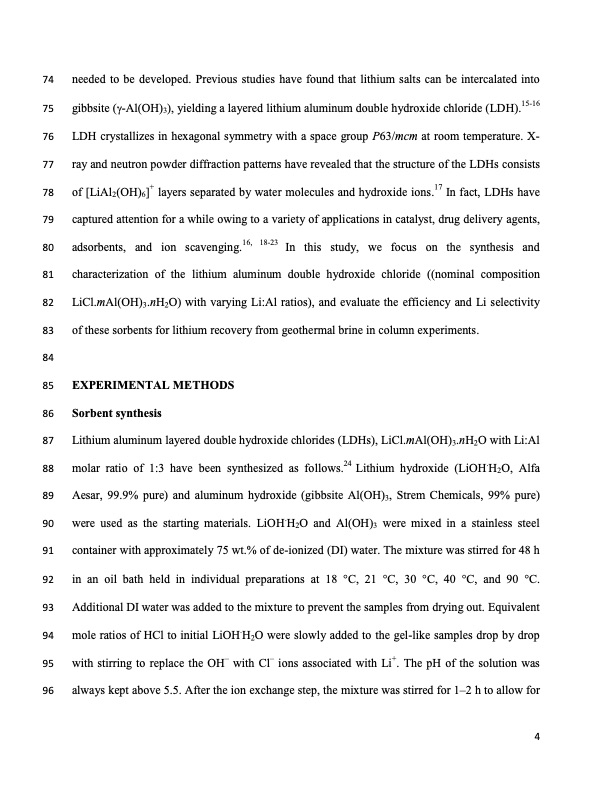
PDF Publication Title:
Text from PDF Page: 004
74 needed to be developed. Previous studies have found that lithium salts can be intercalated into 75 gibbsite (-Al(OH)3), yielding a layered lithium aluminum double hydroxide chloride (LDH).15-16 76 LDH crystallizes in hexagonal symmetry with a space group P63/mcm at room temperature. X- 77 ray and neutron powder diffraction patterns have revealed that the structure of the LDHs consists 78 of [LiAl2(OH)6]+ layers separated by water molecules and hydroxide ions.17 In fact, LDHs have 79 captured attention for a while owing to a variety of applications in catalyst, drug delivery agents, 80 adsorbents, and ion scavenging.16, 18-23 In this study, we focus on the synthesis and 81 characterization of the lithium aluminum double hydroxide chloride ((nominal composition 82 LiCl.mAl(OH)3.nH2O) with varying Li:Al ratios), and evaluate the efficiency and Li selectivity 83 of these sorbents for lithium recovery from geothermal brine in column experiments. 84 85 EXPERIMENTAL METHODS 86 Sorbent synthesis 87 Lithium aluminum layered double hydroxide chlorides (LDHs), LiCl.mAl(OH)3.nH2O with Li:Al 88 molar ratio of 1:3 have been synthesized as follows.24 Lithium hydroxide (LiOH.H2O, Alfa 89 Aesar, 99.9% pure) and aluminum hydroxide (gibbsite Al(OH)3, Strem Chemicals, 99% pure) 90 were used as the starting materials. LiOH.H2O and Al(OH)3 were mixed in a stainless steel 91 container with approximately 75 wt.% of de-ionized (DI) water. The mixture was stirred for 48 h 92 in an oil bath held in individual preparations at 18 C, 21 C, 30 C, 40 C, and 90 C. 93 Additional DI water was added to the mixture to prevent the samples from drying out. Equivalent 94 mole ratios of HCl to initial LiOH.H2O were slowly added to the gel-like samples drop by drop 95 with stirring to replace the OH– with Cl– ions associated with Li+. The pH of the solution was 96 always kept above 5.5. After the ion exchange step, the mixture was stirred for 1–2 h to allow for 4PDF Image | Recovery of Lithium from Geothermal Brine Li AL

PDF Search Title:
Recovery of Lithium from Geothermal Brine Li ALOriginal File Name Searched:
1424451.pdfDIY PDF Search: Google It | Yahoo | Bing
Product and Development Focus for Infinity Turbine
ORC Waste Heat Turbine and ORC System Build Plans: All turbine plans are $10,000 each. This allows you to build a system and then consider licensing for production after you have completed and tested a unit.Redox Flow Battery Technology: With the advent of the new USA tax credits for producing and selling batteries ($35/kW) we are focussing on a simple flow battery using shipping containers as the modular electrolyte storage units with tax credits up to $140,000 per system. Our main focus is on the salt battery. This battery can be used for both thermal and electrical storage applications. We call it the Cogeneration Battery or Cogen Battery. One project is converting salt (brine) based water conditioners to simultaneously produce power. In addition, there are many opportunities to extract Lithium from brine (salt lakes, groundwater, and producer water).Salt water or brine are huge sources for lithium. Most of the worlds lithium is acquired from a brine source. It's even in seawater in a low concentration. Brine is also a byproduct of huge powerplants, which can now use that as an electrolyte and a huge flow battery (which allows storage at the source).We welcome any business and equipment inquiries, as well as licensing our turbines for manufacturing.| CONTACT TEL: 608-238-6001 Email: greg@infinityturbine.com | RSS | AMP |